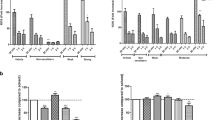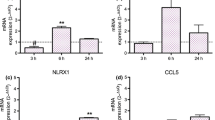Abstract
IL-1 functions as an essential pro-inflammatory mediator for the sensitisation of allergic contact dermatitis (ACD). However, studies conducted to date have typically used a limited number of haptens and examined their effects only on murine ACD or murine dendritic cells (DCs). It therefore remains unclear whether IL-1α and/or IL-1β is produced in ACD induced by haptens other than those commonly used in mouse ACD models, and whether they are essential for sensitisation leading to ACD in humans. In addition, it is unclear whether human DCs also produce IL-1α or IL-1β after stimulation by haptens in general. Here, we first demonstrated that 10 haptens (3 extreme, 1 strong, 3 moderate and 3 weak) increased both IL-1α mRNA and IL-1β mRNA expression by the human monocyte cell line THP-1, a commonly used surrogate of DCs in in vitro skin sensitisation tests. Next, we constructed an in vitro skin sensitisation test using a stable IL-1β reporter cell line, THP-G1b, and evaluated whether 88 haptens and 34 non-haptens increase IL-1β reporter activity. We found that 94% of 77 haptens evaluated after considering their applicability domain and solubility in the chosen media stimulated reporter activity. These studies demonstrated that most haptens, irrespective of their potency, increased IL-1β mRNA expression by THP-1 cells, confirming that human DCs also produce IL-1β after stimulation by most haptens. The luciferase assay using THP-G1b cells is thus another skin sensitisation test based on the adverse outcome pathway with reasonable performance.


Similar content being viewed by others
Availability of data and materials
All the data are available from the corresponding author.
Code availability
Not applicable.
References
Aeby P, Wyss C, Beck H, Griem P, Scheffler H, Goebel C (2004) Characterization of the sensitizing potential of chemicals by in vitro analysis of dendritic cell activation and skin penetration. J Invest Dermatol 122(5):1154–1164. https://doi.org/10.1111/j.0022-202X.2004.22402.x
Aiba S, Terunuma A, Manome H, Tagami H (1997) Dendritic cells differently respond to haptens and irritants by their production of cytokines and expression of co-stimulatory molecules. Eur J Immunol 27(11):3031–3038. https://doi.org/10.1002/eji.1830271141
Antonopoulos C, Cumberbatch M, Dearman RJ, Daniel RJ, Kimber I, Groves RW (2001) Functional caspase-1 is required for Langerhans cell migration and optimal contact sensitization in mice. J Immunol 166(6):3672–3677
Ashikaga T, Sakaguchi H, Sono S et al (2010) A comparative evaluation of in vitro skin sensitisation tests: the human cell-line activation test (h-CLAT) versus the local lymph node assay (LLNA). ATLA 38(4):275–284
Clouet E, Bechara R, Raffalli C et al (2019) The THP-1 cell toolbox: a new concept integrating the key events of skin sensitization. Arch Toxicol 93(4):941–951. https://doi.org/10.1007/s00204-019-02416-7
Corazza M, Lauriola MM, Zappaterra M, Bianchi A, Virgili A (2010) Surfactants, skin cleansing protagonists. J Eur Acad Dermatol Venereol 24(1):1–6. https://doi.org/10.1111/j.1468-3083.2009.03349.x
Enk AH, Katz SI (1992) Early molecular events in the induction phase of contact sensitivity. Proc Natl Acad Sci USA 89:1398–1402
Enk AH, Angeloni VL, Udey MC, Katz SI (1993) An essential role for Langerhans cell-derived IL-1beta in the initiation of primary immune responses in skin. J Immunol 150(9):3698–3704
Gerberick GF, Ryan CA, Kern PS et al (2005) Compilation of historical local lymph node data for evaluation of skin sensitization alternative methods. Dermatitis 16(4):157–202
Gerberick GF, Vassallo JD, Foertsch LM, Price BB, Chaney JG, Lepoittevin JP (2007) Quantification of chemical peptide reactivity for screening contact allergens: a classification tree model approach. Toxicol Sci 97(2):417–427. https://doi.org/10.1093/toxsci/kfm064
Kimura Y, Fujimura C, Ito Y, Takahashi T, Aiba S (2014) Evaluation of the Multi-ImmunoTox Assay composed of 3 human cytokine reporter cells by examining immunological effects of drugs. Toxicol In Vitro 28(5):759–768. https://doi.org/10.1016/j.tiv.2014.02.013
Kimura Y, Fujimura C, Ito Y et al (2015) Optimization of the IL-8 Luc assay as an in vitro test for skin sensitization. Toxicol In Vitro 29(7):1816–1830. https://doi.org/10.1016/j.tiv.2015.07.006
Kimura Y, Watanabe M, Suzuki N et al (2018) The performance of an in vitro skin sensitisation test, IL-8 Luc assay (OECD442E), and the integrated approach with direct peptide reactive assay (DPRA). J Toxicol Sci 43(12):741–749. https://doi.org/10.2131/jts.43.741
Kimura Y, Fujimura C, Aiba S (2020) The modified IL-8 Luc assay, an in vitro skin sensitisation test, can significantly improve the false-negative judgment of lipophilic sensitizers with logKow values > 3.5. Arch Toxicol. https://doi.org/10.1007/s00204-020-02934-9
Livak KJ, Schmittgen TD (2001) Analysis of relative gene expression data using real-time quantitative PCR and the 2(-Delta Delta C(T)) Method. Methods 25(4):402–408. https://doi.org/10.1006/meth.2001.1262
Manome H, Aiba S, Tagami H (1999) Simple chemicals can induce maturation and apoptosis of dendritic cells. Immunology 98(4):481–490
Mizuashi M, Ohtani T, Nakagawa S, Aiba S (2005) Redox imbalance induced by contact sensitizers triggers the maturation of dendritic cells. J Invest Dermatol 124(3):579–586
Nakae S, Naruse-Nakajima C, Sudo K, Horai R, Asano M, Iwakura Y (2001) IL-1alpha, but not IL-1beta, is required for contact-allergen-specific T cell activation during the sensitization phase in contact hypersensitivity. Int Immunol 13(12):1471–1478. https://doi.org/10.1093/intimm/13.12.1471
Nakajima Y, Kimura T, Sugata K et al (2005) Multicolor luciferase assay system: one-step monitoring of multiple gene expressions with a single substrate. Biotechniques 38(6):891–4
Narita K, Ishii Y, Vo PTH et al (2018) Improvement of human cell line activation test (h-CLAT) using short-time exposure methods for prevention of false-negative results. J Toxicol Sci 43(3):229–240. https://doi.org/10.2131/jts.43.229
Natsch A, Emter R (2015) Reporter cell lines for skin sensitization testing. Arch Toxicol 89(10):1645–1668. https://doi.org/10.1007/s00204-015-1555-0
Noguchi T, Ikeda M, Ohmiya Y, Nakajima Y (2008) Simultaneous monitoring of independent gene expression patterns in two types of cocultured fibroblasts with different color-emitting luciferases. BMC Biotechnol 8:40. https://doi.org/10.1186/1472-6750-8-40
OECD (2018) OECD Test Gudeline for the Testing of Chemicals No.442E: In vitro skin sensitisation assays addressing the key event on activation of dendritic cells on the adverse outcome pathway for skin sensitisation. https://doi.org/https://doi.org/10.1787/9789264264359-en.
Pichowski JS, Cumberbatch M, DA Dearman B, Kimber I (2000) Investigation of induced changes in interleukin 1beta mRNA expression by cultured human dendritic cells as an in vitro approach to skin sensitization testing. Toxicol In Vitro 14(4):351–360. https://doi.org/10.1016/s0887-2333(00)00030-8
Pichowski JS, Cumberbatch M, Dearman RJ, Basketter DA, Kimber I (2001) Allergen-induced changes in interleukin 1 beta (IL-1beta) mRNA expression by human blood-derived dendritic cells: inter-individual differences and relevance for sensitization testing. J Appl Toxicol 21(2):115–121. https://doi.org/10.1002/jat.742
Reutter K, Jager D, Degwert J, Hoppe U (1997) In vitro model for contact sensitization: II. Induction of IL-1beta mRNA in human blood-derived dendritic cells by contact sensitizers. Toxicol In Vitro 11(5):619–26
Roberts DW, Patlewicz G (2018) Non-animal assessment of skin sensitization hazard: Is an integrated testing strategy needed, and if so what should be integrated? J Appl Toxicol 38(1):41–50. https://doi.org/10.1002/jat.3479
Sakaguchi H, Ashikaga T, Miyazawa M et al (2006) Development of an in vitro skin sensitization test using human cell lines; human Cell Line Activation Test (h-CLAT). II. An inter-laboratory study of the h-CLAT. Toxicol In Vitro 20(5):774–84. https://doi.org/10.1016/j.tiv.2005.10.014
Shornick LP, De Togni P, Mariathasan S et al (1996) Mice deficient in IL-1beta manifest impaired contact hypersensitivity to trinitrochlorobenzone. JEM 183(4):1427–1436
Takahashi T, Kimura Y, Saito R et al (2011) An in vitro test to screen skin sensitizers using a stable THP-1-derived IL-8 reporter cell line, THP-G8. Toxicol Sci 124(2):359–369. https://doi.org/10.1093/toxsci/kfr237
Watanabe H, Gaide O, Petrilli V et al (2007) Activation of the IL-1beta-processing inflammasome is involved in contact hypersensitivity. J Invest Dermatol 127(8):1956–1963
Yasukawa S, Miyazaki Y, Yoshii C et al (2014) An ITAM-Syk-CARD9 signalling axis triggers contact hypersensitivity by stimulating IL-1production in dendritic cells. Nat Commun 5:3755. https://doi.org/10.1038/ncomms4755
Acknowledgement
This study was supported by Grants-in-Aid from the Ministry of Economy, Trade and Industry (METI), Japan, the Ministry of Health, Labour and Welfare (MHLW), Japan, and the Japanese Society for Alternatives to Animal Experiments (JSAAE).
Funding
This study was supported by Grants-in-Aid from the Ministry of Economy, Trade and Industry (METI), Japan, the Ministry of Health, Labour and Welfare (MHLW), Japan, and the Japanese Society for Alternatives to Animal Experiments (JSAAE), Japan.
Author information
Authors and Affiliations
Contributions
All authors contributed to the study conception and design. Material preparation, data collection and analysis were performed by HT, CF, YK and SA. The first draft of the manuscript was written by SA, and all authors commented on the manuscript. All authors read and approved the final manuscript.
Corresponding author
Ethics declarations
Ethics approval
Not applicable.
Consent for publication
Not applicable.
Consent to participate
Not applicable.
Conflicts of interest
None.
Additional information
Publisher's Note
Springer Nature remains neutral with regard to jurisdictional claims in published maps and institutional affiliations.
Supplementary Information
Below is the link to the electronic supplementary material.
Rights and permissions
About this article
Cite this article
Terui, H., Kimura, Y., Fujimura, C. et al. The IL-1 promoter-driven luciferase reporter cell line THP-G1b can efficiently predict skin-sensitising chemicals. Arch Toxicol 95, 1647–1657 (2021). https://doi.org/10.1007/s00204-021-03022-2
Received:
Accepted:
Published:
Issue Date:
DOI: https://doi.org/10.1007/s00204-021-03022-2




